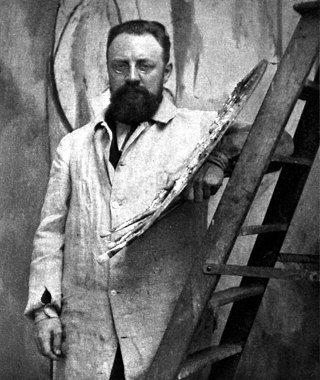
Henri Émile Benoît Matisse was a French visual artist, known for both his use of colour and his fluid and original draughtsmanship. He was a draughtsman, printmaker, and sculptor, but is known primarily as a painter.
Events from the year 1944 in art.
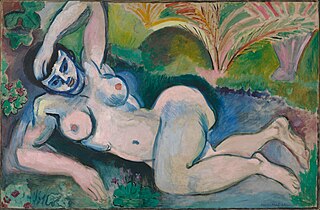
Blue Nude (Souvenir of Biskra) (French: "Nu bleu, Souvenir de Biskra"), an early 1907 oil painting on canvas by Henri Matisse, is located at the Baltimore Museum of Art as part of the Cone Collection.
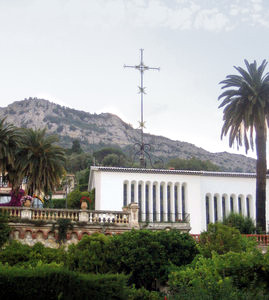
The Chapelle du Rosaire de Vence, often referred to as the Matisse Chapel or the Vence Chapel, is a small Catholic chapel located in the town of Vence on the French Riviera. It was dedicated to the Dominican Order. The church was built and decorated between 1947 and 1951 under a plan devised by the artist Henri Matisse.
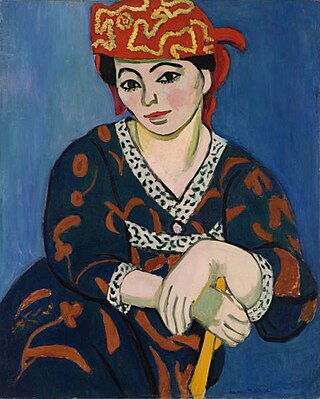
Madras Rouge is a painting by Henri Matisse from 1907. The woman depicted is the painter's wife, Amélie Noellie Parayre Matisse. It is held in the Barnes Foundation, in Philadelphia.

The Open Window, also known as Open Window, Collioure, is a painting by Henri Matisse. The work, an oil on canvas, was painted in 1905 and exhibited at the Salon d'Automne in Paris the same year. It was bequeathed in 1998 by the estate of Mrs. John Hay Whitney to the National Gallery of Art, Washington, DC.

The Painter and His Model is a work by Henri Matisse painted late 1916, early 1917. It is currently in the collection of the Musée National d'Art Moderne, Centre Georges Pompidou, Paris. In this work Matisse depicted himself in his studio on the fourth floor of 19 Quai Saint-Michel, at work on his painting Laurette in a Green Robe (1916).

Le bonheur de vivre is a painting by Henri Matisse. Along with Picasso's Les Demoiselles d'Avignon, Le bonheur de vivre is regarded as one of the pillars of early modernism. The monumental canvas was first exhibited at the Salon des Indépendants of 1906, where its cadmium colors and spatial distortions caused a public expression of protest and outrage.
Purple Robe and Anemones is a 1937 painting by Henri Matisse featuring a woman wearing a purple robe sitting next to a vase of anemones.

Asia is a painting by Henri Matisse. It is an oil on canvas painting from 1946.
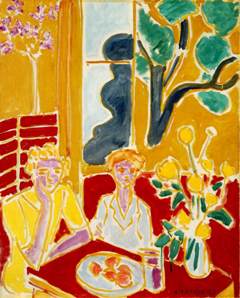
Deux fillettes, fond jaune et rouge (1947), oil on canvas, 61 x 49.8 cm is a painting by Henri Matisse in the collection of the Barnes Foundation, Merion, Pennsylvania.

La Blouse Roumaine is an oil-on-canvas painting by Henri Matisse from 1940. It measures 92 × 73 cm and is held at the Musée National d'Art Moderne in Paris. It depicts a woman in a blue skirt and a white embroidered blouse.

The Snail(L'escargot) is a collage by Henri Matisse. The work was created from summer 1952 to early 1953. It is pigmented with gouache on paper, cut and pasted onto a base layer of white paper measuring 9'43⁄4" × 9' 5" (287 × 288 cm). The piece is in the Tate Modern collection in London.

Woman Reading is an oil-on-board painting executed in 1895 by the French artist Henri Matisse. It is displayed at the Musée Matisse, in Le Cateau-Cambrésis, having been on loan from the Centre Pompidou since 2002. It shows a woman, dressed in black, seated and reading, with her back to the viewer, in the calmness of a somewhat cluttered room. Matisse incorporated a self-portrait into the painting in the form of a framed drawing hanging on the wall at the upper left.

Woman In A Purple Coat or The Purple Coat is a painting by Henri Matisse from 1937. It depicts Matisse's assistant Lydia Delectorskaya. This painting is an example of Henri Matisse's mature decorative style. Matisse depicts his model and companion of many years, Lydia Delectorskaya, in an exotic Moroccan clothing, surrounded by a complex of abstract design and exotic color. This is an example of one of the final groups of oil paintings in Matisse's career, in 1950 he stopped painting oil paintings in favor of creating paper cutouts.

View of Notre-Dame is an oil painting by Henri Matisse from 1914. It is held in the Museum of Modern Art, in New York.
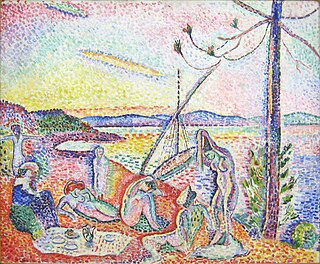
Luxe, Calme et Volupté is a 1904 oil painting by the French artist Henri Matisse. Both foundational in the oeuvre of Matisse and a pivotal work in the history of art, Luxe, Calme et Volupté is considered the starting point of Fauvism. This painting is a dynamic and vibrant work created early on in his career as a painter. It displays an evolution of the Neo-Impressionist style mixed with a new conceptual meaning based in fantasy and leisure that had not been seen in works before.

Music is a wall-size painting made by Henri Matisse in 1910. The painting was commissioned by Sergei Shchukin, who hung it with Matisse's 1910 Dance on the staircase of his Moscow mansion. Matisse made the painting without any preparatory sketches, and thus the painting bears many traces of modifications. One can virtually trace the steps Matisse took to find the intended effect. As in Dance, the aim was to show man's attainment of a state of completeness by immersion in creativity.

Portrait of Greta Moll is a painting by Henri Matisse from 1908. It is part of the National Gallery collection in London.
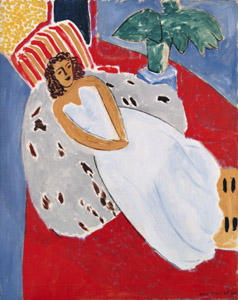
Young Woman in White on a Red Background is an oil on canvas painting by Henri Matisse, from c. 1946. It is held in the Museum of Fine Arts of Lyon.


















